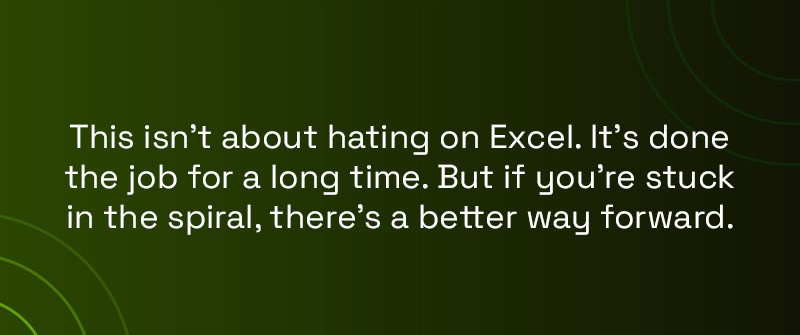
Outgrowing Excel isn’t the problem. Staying stuck in it is.
If your forecasting process involves 12 Excel files, 4 email threads, and a dash of panic, you’re not alone. Spreadsheets work … until they don’t. One version becomes two. A “quick fix” turns into a tangle of formulas no one wants to touch. And before long, you’ve got more tabs than answers and no reliable way to tell what’s right. Your key stakeholders are beginning to ask if your company is outgrowing Excel.
Welcome to the spreadsheet spiral.
What Is the Spreadsheet Spiral?
It starts simple. Someone needs a report. You make a copy. Add a few tweaks. Email it around. Now there are three versions. Next quarter? Multiply that by five departments. Then add some turnover, mismatched data sources, and helper columns no one remembers building. That’s when things start slipping.
You know you’re in the spiral if:
- You spend more time fixing spreadsheets than using them
- Everyone cross-checks files because no one fully trusts the numbers
- Forecasts are late and rarely match what’s happening
- One accidental sort can break everything
Spreadsheets aren’t the problem. But they weren’t built to grow with your business.
And yet, the longer you rely on them, the harder they are to replace. Business logic lives in cell formulas. Institutional knowledge lives in someone’s head. Every quarter adds more copies, more complexity, more questions.
Why the Spiral Doesn’t Stop on Its Own
Most teams try to fix spreadsheet problems with more spreadsheets. Extra tabs, color coding, backups of backups. Eventually, the spreadsheet becomes the system. And everyone quietly agrees not to touch too much or ask too many questions.
Spreadsheets are flexible. That’s why they’ve stuck around. But they don’t scale. They don’t warn you when the logic breaks. They don’t track who changed what. And they don’t stop small errors from snowballing. Even intelligence agencies have learned this the hard way. A single spreadsheet error once led MI5 to wrongly spy on 1,000 innocent people.
And beyond the risks, there’s the issue of visibility. A spreadsheet is like a flashlight, it shows you what’s directly in front of you, but not much else. You might see a single department’s view or one slice of the data, but never the full picture.
The more fragmented the data, the harder it is for teams to align, collaborate, or move quickly. Insight stays locked in silos. Decisions take longer. And trust in the numbers starts to erode.
Outgrowing Excel: A Way Out That Doesn’t Wreck What’s Working

This isn’t about hating on Excel. It’s done the job for a long time. But if you’re stuck in the spiral, there’s a better way forward.
Instead of layering more workarounds, we help teams build systems that reflect how their business actually works. One place to check the numbers. One place to update logic. One place to get clear answers.
You’ll end up with:
- A single version of the truth
- Reports that update without help
- Visuals that make sense to everyone in the room
- Calculations that live in one place and don’t break when you sort a column
And no, you don’t have to start from scratch. The logic in your spreadsheets can be translated into something more durable, more collaborative, and less painful to maintain.
You’re not just getting nicer reports. You’re setting your data up to scale. It’ll be cleaner, more trusted, and ready to support whatever’s next.
What This Looks Like in the Real World
Most teams don’t need a complete overhaul, they just need to stop repeating the same spreadsheet routines and start seeing real improvement. Here’s what it looks like when you get out of the spiral:
- No more relying on one person to remember how column G works
- Forecasts that happen in hours, not days
- One version of the numbers, not five
- More time using reports, less time validating them
It doesn’t take a full rebuild to get these results. Just a clear path forward and the right structure to support it. Same logic. Better structure. Less second-guessing.
Add a Data Strategy Layer
If spreadsheets are your frontline tool, it might be time to think a layer deeper.
A real data strategy doesn’t mean replacing everything. It means aligning your data, calculations, and visuals around the questions your team actually asks. That kind of clarity removes friction from everything, close processes, forecast updates, planning conversations.
It’s not about tools. It’s about logic. We help you find where your current system holds up, where it breaks down, and how to build something more resilient.
A clear data strategy frees your team to focus, spot problems sooner, and move faster when it matters. It also keeps your future self from untangling last quarter’s spreadsheet maze.
Don’t Start Big. Start Smart.
Some of the best improvements don’t come from massive rebuilds. They come from targeted fixes, solving the right problem at the right time. You don’t need a huge team, perfect timing, or flawless data to get started. You just need to pick a pain point and move forward with it.
Here’s how teams typically start:
- Pick one spreadsheet that regularly gives you grief
- Identify what decision it supports-forecasting, headcount, inventory
- Map where the data comes from
- Talk to someone who can help turn that logic into something better
These aren’t big, dramatic changes. They’re practical ones. Small fixes that remove the guesswork and give your team something solid to stand on. It’s about making meaningful progress and building momentum that lasts.
What You Really Get: Trust, Speed, and Breathing Room
This isn’t about dashboards. It’s about trust.
When the numbers are solid, decisions come faster. When the logic is clear, people work together instead of around each other. When the system makes sense, the team can finally breathe.
It makes life easier for the people building the reports, checking the numbers, and answering all the last-minute questions. It’s a relief for the people behind the scenes, too.
That’s the real win, not just better tools, but a better way to work.
The spreadsheet spiral isn’t just annoying. It’s a signal that your business has outgrown its current tools.
It slows things down, hides logic in unexpected places, and adds friction where there should be clarity. Outgrowing Excel doesn’t mean tossing everything. It means building around what already works … just with fewer headaches and more confidence.
And it doesn’t have to be complicated. One view. One decision. One better way to move forward.
The Bottom Line
You don’t need a total overhaul. You need a reporting foundation that fits in with how your business works, one that evolves with your needs instead of slowing you down.
If your team is outgrowing Excel, you’re not alone. We help teams reconnect the logic behind their numbers, so reporting isn’t just faster, it’s something you can count on.
It starts with one spreadsheet. One pain point. One better way forward.
If you’re ready to spend less time chasing files and more time making decisions, we’re here to help.
Get in touch with a P3 team member